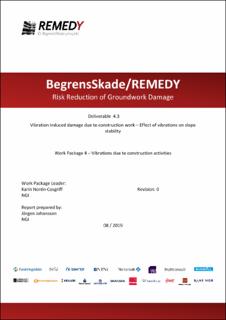Vibration induced damage due to construction work – Effect of vibrations on slope stability
Research report
Permanent lenke
https://hdl.handle.net/11250/3110275Utgivelsesdato
2019-08-29Metadata
Vis full innførselSamlinger
- NGI report [195]
Sammendrag
A landslide-triggered tsunami caused extensive material damage at Statland, Norway in 2014. Other landslides in Sweden and US have also been triggered by man-made vibrations. To understand better how vibrations from vibratory compaction affect slope stability a numerical tool has been extended to account for realistic non-linear soil behaviour. The tool is validated by comparison field experiments of vibratory compaction. The nonlinear analysis is believed to have captured the essential behaviour of the vibratory compaction and the response of the slope. The peak response at the frequency is close to the one stated by the operator of the vibratory roller and the manufacturer's data sheet. The numerical analysis and evaluations strongly indicate vibratory compaction can have contributed to triggering the slide at Statland.
To perform compaction in the vicinity of slopes with low stability near the shoreline with vibration susceptible soils we suggest:
• Using lighter equipment and/or higher loading frequencies or performing compaction without vibration. Avoiding excessive jumping of the vibratory roller drum is imperative.
• Applying thinner layers and more time between compaction passes. Allowing for more time between placing of layers reduces the number of load cycle sensed by the soil and allows for drainage of potential built up pore pressures.
• Monitor slope horizontal and vertical displacements at some critical points.
• Monitor pore pressures at critical points if possible.
Further work with and possible extension of the numerical tool is needed to capture better, the
